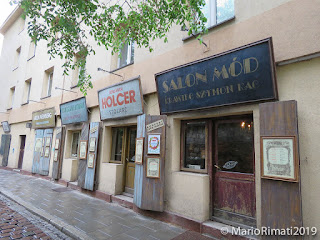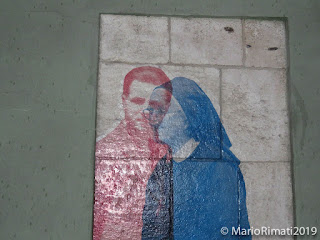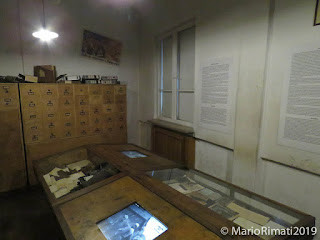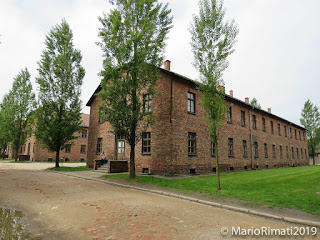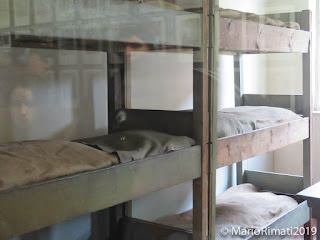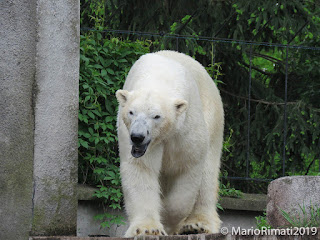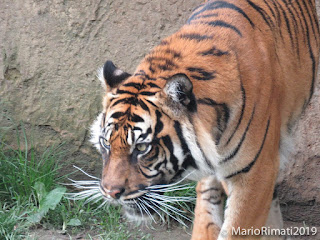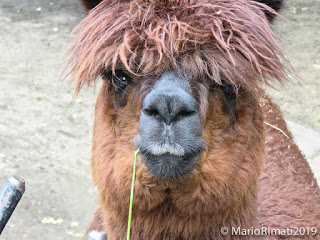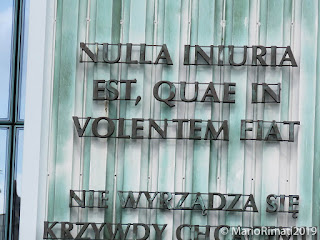I must say that we spent a nice 8 (wet) days in Poland in May, 2019.
We landed in
Krakow with a flight from Rome via Munich.
I had already been to Poland many years ago when with some friends we drove from Udine to the old Polish capital to then go to Auschwitz-Birkenau which is
only 70 kms away.
This time we spent
a few days in Krakow, indeed a very nice and clean town. Our hotel was in the old ghetto and very
quiet, so quiet that we were right next to the old Jewish cemetery. The historic center, which I believe is a
UNESCO world heritage site, is also very nice as is the town’s castle.
We also made it to
Oskar Schindler’s factory-museum, the very same one which had been used by Spielberg in 1993
when he shot “Schindler’s List” there.
We also tried to see the concentration camp nearby which was re-built
for the movie but not much is left of it. As you can see from the pics here below it's indeed a rather touching museum.
From there we took a tram back to the city center. A real treat for the Leonardo da Vinci
aficionado that I am as we got to see his only work of art in Poland: the “Lady
With An Ermine”! A pity you’re not
allowed to take pics of the magnificent painting
but with a good Canon zoom lens you can (almost) get away
with murder!
Da Vinci's magnificent “Lady With An Ermine”!
I'm sort of "singing in the rain"!
Krakow's synagogue which had been completely destroyed by the Nazis. Apparently, it's Poland's oldest.
Krakow's castle and the tomb of Poland's former president and his wife who along with the entire Polish government perished in an air crash.
Da Vinci's magnificent “Lady With An Ermine”!
I'm sort of "singing in the rain"!
Krakow's synagogue which had been completely destroyed by the Nazis. Apparently, it's Poland's oldest.
Krakow's castle and the tomb of Poland's former president and his wife who along with the entire Polish government perished in an air crash.
Krakow's massive indoor shopping center. The place is HUGE!
We left Krakow with a rented car for Auschwitz-Birkenau. We got there at
about 9.30 am and thought that we could get in for free, which you can, but we
didn’t so we instead had to pay and got stuck (in a nice way) with an
English-speaking tour guide who turned out to be very thorough in her explanation of the site which saw THE worst mass massacre in history (more
people, 1.1 million, died in A-B than the combined number of deaths of British
and American soldiers during World War II).
The “welcome” sign
over the main gate of A always hits you like a ton of bricks, “Arbeit
Macht Frei”, which had been actually imported from the first
concentration camp under the Nazis, the one at Dachau, only 18 km from Munich
(been to that one twice). The same sign also hangs
at the Buchenwald camp near Weimar (been to that one too).
The first time I
went to A-B we spent 4 hours in A and 3 in B, with a lunch break in between
(but luckily NOT right in front of A’s entrance as I don’t think it’s terribly
fitting to eat and drink at a site where people died of starvation and thirst in tiny cells). This time we only spent
2 hours in A and 1 in B, a pity as it’s the second time I go to B and I can’t
seem to visit the entire camp which is simply HUGE, like an average small Italian
town (B contained 300 barracks for the prisoners)!
Even though it was
the second time for me it was nevertheless a moving experience, especially to see the
infamous room full of the prisoners’ luggage (your entire life had to be
crammed into just one piece of luggage, or 25 kg worth of stuff) as well as their shoes. It was also moving to see the outfits of
young Jewish children as well as their small shoes. At one point our guide Agata turned to us and asked, “And
so what did you pack in just one piece of luggage”?
Some of the cells
in the various blocks could hold several prisoners who were purposely starved
to death and who tried surviving without a drop of water. When you see these cells, including the one
where Father Maximilian Kolbe was kept along with 3 other prisoners (he
sacrificed his life for another prisoner), you always ask yourself whether
euthanasia, which actually began under the Nazis with their very own euthanasia
program, a program intended to eliminate the weak and the insane from
German society, is right or wrong when it’s left up to others to decide the
fate of a person, as what happened in these camps more than 75 years ago (in
the case of the extermination camp at Treblinka, located just 100 km north of
Warsaw where 900,000 people perished, you were dead within 2 hours that you had
stepped off of the trains as you marched directly into the gas chambers).
Poetic justice: as
we walked around A we were shown the villa that had belonged to the commandant
of the two camps, Rudolf Höss
not to be confused with Rudolf Hess, Hitler’s right-hand man who died, the only prisoner too, at Spandau prison). Höss had worked for 6 years at Dachau and was there on a murder charge. He had been handpicked by concentration camp boss supremo Heinrich Himmler to run A-B. His villa is located right just over the barbed-wire fence at A.
not to be confused with Rudolf Hess, Hitler’s right-hand man who died, the only prisoner too, at Spandau prison). Höss had worked for 6 years at Dachau and was there on a murder charge. He had been handpicked by concentration camp boss supremo Heinrich Himmler to run A-B. His villa is located right just over the barbed-wire fence at A.
Just after the war Höss went into hiding. He was eventually
caught by the British army (he was working on a farm), tried and sentenced to death. And so where did he die at the hands of the
hangman? At the gallows pole (which is
still there) right between his villa and A’s crematorium. Two things came to my mind seeing that gallows pole, “And justice for all” (with Al Pacino) and this famous Zep song, https://www.youtube.com/watch?v=X9DuDgzGjtE
We hitched a ride on
the camp’s bus after our visit in A to nearby Birkenau, about 6 km away. We were again accompanied by our guide
Agata. The only train wagon that is
still there could hold up to 100 people who would be traveling to B for up to 7 days
and quite often without water.
As you got off the trains there was the SS and in particular the “Angel Of Death”, Dr. Josef Mengele (who eventually escaped after the war to South America) the very same man who used to perform his grotesque experiments on kids and twins, directing traffic: with the sway of a hand, and just like an orchestra leader, he’d order prisoners to the left or to the right. If you were lucky enough to go to the left you went to work in the camp. If you weren’t so lucky you’d go to the right, you’d walk about 400 meters along a path (the very same one we took that day) which led you directly to the gas chambers and then to the crematoria.
The crematoria at B? Not much is left of them except the rubble. As the Soviet Red Army was advancing from the east the Nazis were re-treating and along the way burned important camp documents and also blew up the gas chambers and the crematoria (but not the one in A).
You still though get an idea of the horrendous pain and suffering that went on there until the Soviets arrived to liberate the camp on January 27th, 1945.
One thing of comfort for the prisoners, especially the women, was the “Canada House”, a special barrack where the women would work dividing up the prisoners’ clothes and checking for their valuables (which ended up getting pilfered by the corrupt SS soldiers there). The name was chosen because prisoners thought that Canada was a land of plenty and gave them some hope that indeed a better world existed out there.
And the barracks? The bunk beds (if one can call them “beds”) could contain up to 12 prisoners per bunk bed, or 4 prisoners to each level. The ones on the ground level were the worst off. During my first visit to B we also saw some of the barrack washrooms (the word “washroom” is a mighty big word as they were simply disgusting)!
Our visit
concluded in B and back on the bus for A.
From there we took the highway for Warsaw, about 350 km north of Oswiecim
(Auschwitz’s name in Polish). For further detailed (very detailed!) information on the Konzentrationslager, the German word for concentration camp, I highly recommend Professor Nikolaus Wachsmann's 800-page book, "KL, a History Of The Concentration Camps".
We only went through one toll booth so the highway trip cost-wise was rather minimal. But not the time it took to get to Poland’s capital as we had come across a rather long line-up of cars and trucks along the way. Somewhere along the highway there had been quite the accident (which we couldn't see) so we were detoured along Poland’s country roads.
We only went through one toll booth so the highway trip cost-wise was rather minimal. But not the time it took to get to Poland’s capital as we had come across a rather long line-up of cars and trucks along the way. Somewhere along the highway there had been quite the accident (which we couldn't see) so we were detoured along Poland’s country roads.
The detour was
about 90 minutes long and we were literally moving at one point at a snail’s
pace. That type of driving, at least for me, is rather tiring.
Once we managed to
get back to the main highway it was an easy cruise into Warsaw. We got there at about 9 pm and eventually
made our way to the central hotel which had a staff that was somewhat reminiscent of
concentration camp staff members (let us just say that they
weren’t very “user friendly”). But the
room was very spacious and comfy and had stuff to make morning coffee (we opted to not
have breakfast as it cost a wee bit too much). We’d stock up the night before on cookies and
croissants so our in-the-hotel-room-breakfast was just fine.
In all honesty, I
wasn’t excepting such a dynamic capital, in many ways similar to an average
North American city with many tall skyscrapers. The town was very clean, just like Krakow,
and with a total absence (again, just like in Krakow) of Chinese shops and Bengali street hawkers, both which are very common in Rome and in other
Italian cities. At this point I thought
that the Poles are either somewhat racist and don’t want immigrants (half of
Poles want LESS immigration in their country, according to a recent Economist
issue) or they’re more serious than Italy when it comes to handling immigration-related
issues.
The rather amazing
thing about Warsaw’s dynamism is that 95% of the town had been totally
destroyed in 1944 and eventually re-built from scratch. In fact, in the center there’s a UNESCO
plaque as the city is a world heritage patrimony site.
Very touching the
presidential palace in the center of the town.
There’s a large cement plaque commemorating the tragic death of Poland’s
former president, Lech Kaczynski (he had a twin brother), and his entire government in an air crash in 2010 in
Smolensk. Up to 96 people, including
the air crew, perished in that crash as Kaczynski were going (or coming back
from) from a commemoration of the massacre of 4,000 Polish officers in a forest near Katyn aboard a Russian-made aircraft
(the Soviets always denied that massacre and for decades had blamed the Nazis. The order instead had come from Stalin himself). Conspiracy theory aficionados suspect that it
was the hand of Putin’s people behind that tragedy. Some also suspect that the
crash was due to bad weather and/or because of the bad weather the plane had to
land elsewhere, thus irritating the president on board who didn’t want to have
the flight plan changed. We also saw
his tomb in the cathedral in Krakow’s castle.
He’s buried there along with his wife.
We spent the Sunday
morning at Warsaw’s zoo, something that I personally haven’t done for
years. The reason why we chose to go
there was based on a 2017 movie, a true story, on that very same zoo and the
Warsaw ghetto uprising. An SS officer in that movie is the same actor who
played Niki Lauda in Ron Howard’s movie “Rush”. It was interesting to see the tigers,
elephants, baboons, rhinos, etc. but unfortunately the king of the forest
himself, the lion, refused to make his appearance!
The food: no major
problems with Polish cuisine. I must say
we ate rather well and it wasn’t terribly expensive either (Poland may be in
the EU but it’s not in the Euro as it uses its own currency, the zloty). Great beer too!
And the people? It
may be that when I open my mouth many in the “Old Europe” (as Donald Rumsfeld
once called us) take me for an American so I seem to have a wee bit more
respect, or at least better service, than someone who doesn’t know English very
well (like the average Italian, from what I’ve seen in my many travels around
Europe). When I’m in a country like
Germany and I tell the locals that I’m Canadian-born I get even more
respect, and even MORE in jolly old England as I’m a loyal subject of the
Commonwealth.
I was looking at
my cell phone and a web site on Warsaw.
Someone said that it was a “boring” city. Au
contraire! From what I saw it
seems like a rather fun town in which to live, especially if you’re a student,
with a very good transportation system and without the “claustrophobic” feeling
that you get living in Rome (albeit Warsaw has only 1.7 million people compared
to Rome’s 3.5 million, more or less). Cars in Rome seem to be everywhere!
And the return flight to Rome via Frankfurt? A small nightmare as we left with a two-hour delay from Warsaw’s Chopin airport (so what else could Warsaw’s main airport be called?). We arrived in Frankfurt and up to 160 flights had been cancelled due to a massive thunderstorm (due to climate change?). In fact, as we were landing we actually saw a lightning bolt outside the plane’s window with a large cracking sound. This brought to mind AC/DC’s great song, “Thunderstruck”, as lead guitarist Angus Young had actually been on a plane when it once got hit by a lightning bolt. How nice that our pilot reassured us by saying that “We will land in Frankfurt”!





